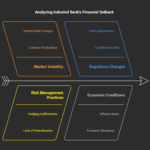In the realm of analytical tasks, none proves more challenging and humbling than assessing management. From early on, those who succeed learn the art of concealing emotions and thought patterns. While identifying a singular talent among individuals can be daunting, the task of evaluating an entire management team presents challenges of a significantly greater magnitude.
The Power of Numbers in Management Assessment
To unravel the enigma of management assessment, we must first direct our focus toward the most tangible clue: the numbers.
In the world of sports analysis, a lesson from “handicapping” at the racetrack is to approach extended winning streaks with skepticism. Exceptional performers do experience off days. Unraveling the reasons behind a deviation from a sustained trend line is a valuable pursuit. However, such reasons are not always readily discernible.
Yet, I find comfort in dismissing an occasional anomaly when forecasting the future. Unless substantial changes have occurred, I tend to consider an 80% alignment with a trend as a valuable element for future predictions. Moreover, the Bernie Madoff scandal taught us that perfection can often be a façade for deception.
While navigating the landscape of financial statement analysis, it’s important to note that not every stock within a sustainable growth portfolio will mirror these criteria precisely. However, the weighted average of the holdings should reflect such attributes. I won’t delve into each line item of the Income Statement and Balance Sheet. Nonetheless, each component can significantly influence a prudent investor’s decision-making process, often more than a press release touting an XX% increase in EPS. This rings particularly true when GAAP accounting earnings diverge substantially from more popular non-GAAP figures.
Unveiling Insights through Key Financial Metrics
Operating Revenues:
In the business arena, a sale solidifies belief. Once I grasp the nuances of revenue recording, I seek consistent growth outpacing that of the sector. A one-time sale can resemble a fleeting encounter. Though not frequently highlighted, repeat sales signify that the customer perceives the product as a solution to their problem.
Sustained revenue from the same customer demonstrates dependence, a cornerstone of lasting relationships. Furthermore, market share expansion indicates competitive prowess, except for the price leader, which might prioritize business acquisition by emphasizing price over value.
Being recognized as the low-cost producer holds immense value. Yet, it’s akin to sacrificing the future for immediate gain. Conversely, being acknowledged as such can instill price discipline in competitors. Savvy analysts lower sales growth estimates if returns and warranty costs escalate.
Gross Margins:
For companies producing goods, the direct cost of generating sales typically accounts for about half of the revenues over a market cycle, yielding a gross margin of 40%–60%. Service-centric companies, with labor costs as their primary expenditure, may exhibit lower gross margins due to reduced depreciation related to plant and equipment.
Financial service entities often utilize borrowed capital, incurring interest costs that diminish margins relative to product manufacturers. Shrinking gross margins may raise concerns, indicating a potential decline in competitive standing among peers or susceptibility to substitute products from external sources.
Operating Margins:
Beyond the cost of producing goods and services lies an array of other expenses, including selling, general, and administrative (SG&A) costs. These encompass research and development for new products, periodic charges, depreciation, and other expenditures, often involving interest expenses.
My preference lies in a net interest metric that calculates the difference between interest earned and interest paid/accrued. Substantial net interest raises questions about a company’s capital structure and its plans for rectification. Operating margins, on the whole, can lag behind gross margins by around 20 percentage points.
Income Tax Rates:
Analysts seek insight into paid or accrued income taxes, along with the underlying differences and their implications for the future. Skillful tax management receives applause if it doesn’t constrict the company’s future actions.
Impact of Foreign Sales and Earnings Translation:
While long-term investors might not heavily value currency translation gains and losses, hedging choices reveal management’s stance on short-term results. Hedging methods vary, from derivatives to local currencies, impacting the foreign exchange market. Long-term strategies involve balancing sales and earnings from various foreign countries with the home currency. Understanding the currency of expenses, profits, and tax payments is equally crucial.
Insightful Reporting on Industrial Landscape
A proficient analyst sources information from diverse markets and major price trends. The reporting company, ideally unbiased, should serve as a critical element provider. Absence of such information signifies a lack of concern for shareholder welfare.
Navigating Balance Sheet Nuances
Inventory levels can provide key signals. Rising inventory, especially finished products and, to a lesser extent, work in progress, may indicate a need to lower prices or improve terms. Elevated raw material inventory might signify speculative behavior or a competitive strategy of creating artificial scarcity. Changes in inventory demand comprehension.
Physical assets like plant and equipment, recorded at historical cost minus accumulated depreciation, offer insights into competitors’ relative production costs. Intellectual property, a potential moat, can shield a company from competitors. However, the dependency of clients on the company’s products and services, and their attitude toward that reliance, eclipse the importance of intellectual property.
Unsettled taxes offer valuable float but require thorough recording like all liabilities. Identifying off-balance-sheet contingency reserves is an analyst’s duty. The absence of such reserves can be problematic.
Cracking the Code of Effective Processes
For sustainable growth, well-defined processes are essential. A comprehensive research report summarizes processes for regulators and shareholders. Well-documented processes safeguard against management changes and assist in regulatory inspections.
Many institutional investors lack full comprehension of their portfolio companies’ critical processes. Consequently, during market disruptions, investors remain uncertain until receiving thorough communication from the company. This uncertainty can trigger unwarranted but convincing rumors leading to position sales.
Unveiling Management’s Role
Past history offers partial insight, yet it’s no guarantee. As Warren Buffett states, a business’s reputation often overshadows brilliant management in a poorly structured enterprise. Evaluating existing management’s ability to steer the company toward a promising future demands attention to:
- Integrity: Beyond legality, intellectual honesty is vital, as some individuals deceive themselves.
- Innovation: Innovation in products and processes underpins long-term success.
- Interpersonal Dynamics: How executives treat each other reflects their approach to debt and equity holders.
- Effective Controls: Comprehensive control over people, finances, and processes sustains discipline crucial for success.
Engaging in discussions surrounding these notions holds great promise.
Personally Recommend: https://amzn.to/47lCxQO











